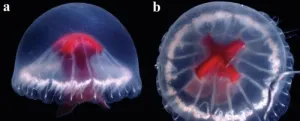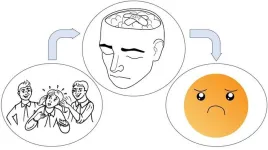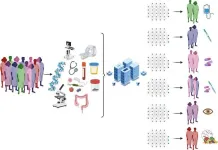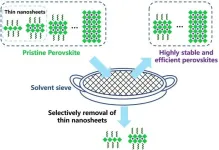(Press-News.org) Researchers from University of California San Diego, as part of a large collaboration with scientists around the world, have developed a new search tool to help researchers better understand the metabolism of microorganisms. Microbes are key players in virtually all biological and environmental systems, yet limitations in current techniques used to study microbial metabolism make it difficult to decode their interactions and activities.
The new research, published February 5, 2023 in Nature Microbiology, directly addresses these limitations, which could ultimately transform our understanding of both human health and the environment.
“Humans are walking ecosystems in which microbes vastly outnumber us, but we know so little about the metabolites that microbes produce,” said senior study author Pieter Dorrestein, PhD, professor of pharmacology and pediatrics at UC San Diego School of Medicine and professor at Skaggs School of Pharmacy and Pharmaceutical Sciences at UC San Diego. "This technology allows us to match microbes to the metabolic signatures they produce without any prior knowledge, which represents a major leap forward in our ability to study microorganisms and their intricate relationships with humans and ecosystems.”
The groundbreaking tool, which the scientists call microbeMASST, was developed by scientists at UC San Diego’s Collaborative Microbial Metabolite Center, an NIH-supported initiative that aims to build an internationally-curated repository of microbial metabolomics data to help researchers studying the complex interaction between microbes and humans.
Beneficial microbes play a key role in human health by colonizing certain areas of the body, including the skin, where they protect us against external pathogens, and the gut, where they contribute to essential functions such as nutrient absorption and regulating the immune system. Disruption of the microbial communities in our body is associated with a wide range of diseases.
“This resource will help us mechanistically interrogate the role of the microbiome in health conditions such as liver disease, inflammatory bowel disease, diabetes, atherosclerosis and others,” added Dorrestein.
Microbes are also at the center of important environmental processes, such as the carbon and nitrogen cycles. When microbial communities involved in these processes are disrupted, it can become harder for ecosystems to cycle nutrients, leading to a wide range of destructive ecological imbalances.
Because of their crucial role in the environment and their interactions with larger organisms, the metabolism of microbes is a driving force in virtually all aspects of biology. However, the vast metabolic potential of microbial communities is often overlooked in modern experiments, which generally only look at microbial metabolism with a wide lens.
“One of the challenges of studying microbes at the molecular level is that it’s difficult to tell which microbes are producing which molecules unless you already know what you’re looking for,” said first author Simone Zuffa, a postdoctoral researcher working with Dorrestein. “If you think of colonies of microbes as crowded parties with lots of people talking, our current experiments can only record the sound, but we want to figure out a way to unscramble that audio to figure out who is saying what.”
To help produce the new search tool, which the researchers have called microbeMASST, researchers from the Collaborative Microbial Metabolite Center at UC San Diego collected more than 100 million data points from 60,000 distinct microbial samples, gathered by scientists from across the world. This database has been meticulously curated from community contributions and metadata curation, and includes microbes from plants, soils, oceans, lakes, fish, terrestrial animals and humans.
By cross-referencing an experimental sample with this massive library of individual microbes, microbeMASST can detect which microbes are present in that sample.
“There’s no existing tool that can do this, and ours can do it in seconds,” added Zuffa.
Because microbeMASST can identify microbes in a sample without any prior knowledge, the researchers are confident that the applications of the technology extend into various fields of biology, such as aquaculture, agriculture, biotechnology, and studying microbial-mediated health conditions.
“We anticipate that microbeMASST will be a transformative resource for the life sciences research community,” said Dorrestein. “Further, the tool will only improve over time as the community gathers more data for the system to reference.”
Full link to study: https://www.nature.com/articles/s41564-023-01575-9
UC San Diego co-authors on the study include: Simone Zuffa, Robin Schmid, Anelize Bauermeister, Paulo Wender P. Gomes, Andres M. Caraballo-Rodriguez, Yasin El Abiead, Jasmine Zemlin, Michael J. Meehan, Allegra T. Aron, Nicole E. Avalon, Nuno Bandeira, William H. Gerwick, Ekaterina Buzun, Marvic Carrillo Terrazas, Chia-Yun Hsu, Renee Oles, Adriana Vasquez Ayala, Jiaqi Zhao, Hiutung Chu, Mirte C. M. Kuijpers, Sara L. Jackrel, Benjamin S. Pullman, Rob Knight and Daniel McDonald.
Additional co-authors include: Alegra T. Aron at University of Denver, Emily C. Gentry at Virginia Tech, Robert H. Cichewicz at University of Oklahoma, Fidele Tugizimana, Lerato Pertunia Nephali and Ian A. Dubery at University of Johannesburg, Ntakadzeni Edwin Madala at University of Venda, Eduarda Antunes Moreira, Leticia Veras Costa-Lotufo, Norberto Peporine Lopes and Paula Rezende-Teixeira at University of São Paulo, Paula C. Jimenez at Federal University of São Paulo, Bipin Rimal, Andrew D. Patterson, Matthew F. Traxler and Rita de Cassia Pessotti at Pennsylvania State University, Daniel Alvarado-Villalobos, Giselle Tamayo-Castillo, Priscila Chaverri, Efrain Escudero-Leyva and Luis-Manuel Quiros-Guerrero, at University of Costa Rica, Alexandre Jean Bory, Juliette Joubert, Adriano Rutz, Jean-Luc Wolfender and Pierre-Marie Allard at University of Geneva, Andreas Sichert and Sammy Pontrelli at ETH Zurich, Katia Gindro and Josep Massana-Codina at Agroscope, Berenike C. Wagner, Karl Forchhammer and Daniel Petras at University of Tuebingen, Nicole Aiosa and Neha Garg. At Georgia Institute of Technology, Manuel Liebeke and Patric Bourceau at Max Planck Institute for Marine Microbiology, Kyo Bin Kang at Sookmyung Women’s University, Henna Gadhavi, Luiz Pedro Sorio de Carvalho and Mariana Silva dos Santos at The Francis Crick Institute, Alicia Isabel Pérez-Lorente, Carlos Molina-Santiago and Diego Romero at Universidad de Málaga-Consejo Superior de Investigaciones Científicas Raimo Franke and Mark Brönstrup at Helmholtz Centre for Infection Research, Arturo Vera Ponce de León, Phillip Byron Pope and Sabina Leanti La Rosa, Norwegian University of Life Sciences, Giorgia La Barbera and Henrik M. Roager at University of Copenhagen, Martin Frederik Laursen, Technical University of Denmark, Fabian Hammerle, Bianka Siewert and Ursula Peintner at University of Innsbruck, Cuauhtemoc Licona-Cassani and Lorena Rodriguez-Orduña at Tecnologico de Monterrey, Evelyn Rampler, Felina Hildebrand, Gunda Koellensperger, Harald Schoeny, Katharina Hohenwallner and Lisa Panzenboeck at University of Vienna, Rachel Gregor, at Massachusetts Institute of Technology, Ellis Charles O’Neill, Eve Tallulah Roxborough and Jane Odoi at University of Nottingham, Nicole J. Bale, Su Ding and Jaap S. Sinninghe Damsté at Netherlands Institute for Sea Research, Xue Li Guan at Nanyang Technological University, Jerry J. Cui and Kou-San Ju at The Ohio State University, Denise Brentan Silva and Fernanda Motta Ribeiro Silva at Federal University of Mato Grosso do Sul, Gilvan Ferreira da Silva at Embrapa Amazônia Ocidental, Hector H. F. Koolen at Universidade do Estado do Amazonas, Carlismari Grundmann at University of São Paulo, Ribeirão Preto, Jason A. Clement at Baruch S. Blumberg Institute, Hosein Mohimani at Carnegie Mellon University, Kirk Broders at the US Department of Agriculture, Kerry L. McPhail at Oregon State University, Sidnee E. Ober-Singleton at University of Oregon, Christopher M. Rath in Emmeryville CA and Mingxun Wang at University of California, Riverside.
This study was funded, in part, by the National Institutes of Health (grants U24DK133658, U19AG063744, 1DP2GM137413, F32AT011475, R01 GM107550, R01 GM137135, U01 DK119702, S10 OD021750, 1R01LM013115, 1R01GM132649, DP1AT010885, T32 DK007202), the National Science Foundation (grant 2152526), the U.S. Department of Agriculture, Agricultural Research Service, the National Research Foundation of Korea (grants NRF-2020R1C1C1004046, NRF-2022R1A5A2021216 and NRF-2022M3H9A2096191), the Austrian Science Fund (grant P31915), the German Research Foundation (grants EXC 2124 and TRR 261), the São Paulo Research Foundation (grants #2018/24865-4, #2019/03008-9, #2020/06430-0, #2022/12654-4, #2015/17177-6, #2020/02207-5, #2021/10603-0), National Council for Scientific and Technological Development (CNPq), the Research Council of Norway (grant 311913), the Novo Nordisk Foundation (grant NNF19OC0056246), the Independent Research Fund Denmark (grant 0171-00006B), ERA-Net Cofund project BlueBio (grant 311913), Fundação de Amparo à Pesquisa do Estado do Amazonas, Fundação de Apoio ao Desenvolvimento do Ensino, Ciência e Tecnologia do Estado de Mato Grosso do Sul - FUNDECT (grants 71/032.390/2022 and 311/2022), the Betty and Gordon Moore Foundation and the Max Planck Society.
END
New technology unscrambles the chatter of microbes
Using a database of over 60,000 microorganisms curated by researchers from across the globe, the new search tool instantly matches microbes to the metabolites they produce
2024-02-05
ELSE PRESS RELEASES FROM THIS DATE:
Pulmonary rehabilitation is difficult for millions of Americans to access
2024-02-05
New Haven, Conn. — Pulmonary rehabilitation, an essential component of care for patients with chronic respiratory conditions, is difficult for millions of Americans to access, a new Yale-led study reveals. The findings, researchers say, reveal geographic regions where this type of care is most lacking and illustrate the potential for telemedicine in helping to bridge this gap.
The study was published Feb. 5 in JAMA Network Open.
Pulmonary rehabilitation is a multidisciplinary program that incorporates exercise and strategic techniques to improve quality of life and overall health for patients with respiratory conditions like chronic ...
Bacterial test for raw, organic milk may require more precision
2024-02-05
ITHACA, N.Y. -- Cornell food scientists show that a standard quality test used for raw, organic milk is insufficient for distinguishing between specific groups of bacteria, suggesting that the criteria for determining milk quality at processing plants needs to be updated.
Their work was published Jan. 20 in the Journal of Dairy Science.
“Testing milk should not be one size fits all,” as tests should be used appropriately to give the best feedback to dairy producers, said lead author Renee Lee ’21, ...
Brazilian researcher helps describe a novel species of jellyfish discovered in a remote location in Japan
2024-02-05
A gelatinous animal with a diameter of about 10 cm and a red stomach resembling the Cross of St George when seen from above. This is Santjordia pagesi, a newly described species of medusa. Medusae are a type of free-swimming, umbrella-shaped jellyfish with a reduced stalk.
The new species is described in an article published in the journal Zootaxa. The study was conducted by an international group of researchers that included a Brazilian scientist supported by FAPESP.
The scientist in question is André Morandini, last author ...
Small but mighty – study highlights the abundance and importance of the ocean’s tiniest inhabitants
2024-02-05
Tiny plankton – measuring less than 20µm (or 0.02mm) in diameter – make up the majority of plankton in the ocean and play a critical role in the planet’s health, according to new research.
However, scientists say challenges in identifying them have led to them becoming a silent majority that is currently being overlooked when it comes to global ocean policy.
The study is one of the first to explore the abundance and importance of these tiny ocean inhabitants around the UK coastline, with the technology capable of monitoring them only having been introduced in around 2010.
However, ...
Bullied teens’ brains show chemical change associated with psychosis
2024-02-05
Researchers have found that adolescents being bullied by their peers are at greater risk of the early stages of psychotic episodes and in turn experience lower levels of a key neurotransmitter in a part of the brain involved in regulating emotions. The finding suggests that this neurotransmitter — a chemical messenger that transmits nerve impulses for communication by a nerve cell — may be a potential target for pharmaceutical interventions aimed at reducing the risk of psychotic disorders.
Psychosis is a mental state characterized by loss of contact with reality, incoherent speech and behavior, and typically hallucinations and delusions seen in psychiatric disorders ...
Unlocking precision medicine for inflammatory bowel disease
2024-02-05
The prevalence of inflammatory bowel disease (IBD), encompassing ulcerative colitis (UC) and Crohn's disease (CD), is rapidly increasing worldwide, affecting an estimated 6.8 million people. This surge brings significant economic burdens, with annual healthcare costs exceeding $12,000 and $7,000 for CD and UC patients, respectively. Tailored drug selection based on individual factors can potentially reduce these costs and improve patient outcomes.
Factors associated with a Western lifestyle such as urbanization, high animal protein intake, ultra-processed foods, and reduced fiber ...
High production of polyols using crude glycerol by wild-type safe yeasts
2024-02-05
Utilizing crude glycerol for the synthesis of high-value products offers a promising solution to counter the adverse effects of declining glycerol prices in the biodiesel sector. The prevalence of crude glycerol, a by-product of biodiesel production, across agriculture, biofuel, and industrial sectors is steadily rising. Recent advancements have demonstrated the effectiveness of both wild-type and mutant yeast strains as microbial cell factories capable of converting glycerol into a diverse array of valuable compounds, including microbial oils, sugar-alcohols (polyols), and organic acids. With the projected increase in biodiesel production, there is a need to explore integrated ...
Solvent sieve method sets new record for perovskite light-emitting diodes
2024-02-05
Using a simple solvent sieve method, researchers from the Ningbo Institute of Materials Technology and Engineering (NIMTE) of the Chinese Academy of Sciences (CAS) have taken the lead in developing highly efficient and stable perovskite light-emitting diodes (PeLEDs) with record performance.
The study was published in Nature Photonics.
Perovskites are one of the most promising optoelectronic materials due to their excellent optoelectronic performance and low preparation cost. Compared with traditional organic light-emitting diodes (OLEDs), PeLEDs have a narrower light-emitting spectrum and superior color ...
Combination therapy lowers blood pressure in patients receiving ibrutinib
2024-02-05
(WASHINGTON, Feb. 5, 2024) – Combination treatments with two or more blood pressure drugs can significantly reduce blood pressure in patients taking ibrutinib, according to a new study published in Blood Advances.
Targeted drugs such as ibrutinib have improved outcomes for patients with cancers of the lymphatic system, but patients treated with ibrutinib and other drugs in its class often develop new or worsening high blood pressure (or hypertension or HTN). Few studies have examined how best to treat this potentially serious side effect, nor do any formal guidelines exist to steer doctors toward the most effective treatments.
“To ...
Ultra-sensitive lead detector could significantly improve water quality monitoring
2024-02-05
Engineers at the University of California San Diego have developed an ultra-sensitive sensor made with graphene that can detect extraordinarily low concentrations of lead ions in water. The device achieves a record limit of detection of lead down to the femtomolar range, which is one million times more sensitive than previous sensing technologies.
“With the extremely high sensitivity of our device, we ultimately hope to detect even the presence of one lead ion in a reasonable volume of water,” said Prabhakar Bandaru, a professor in the Department of Mechanical and Aerospace Engineering at the UC San Diego Jacobs School of Engineering. “Lead exposure is a serious health concern, ...
LAST 30 PRESS RELEASES:
DNA tests reveal mysterious beluga family trees
Strategic sex: Alaska’s beluga whales swap mates for long-term survival
How early cell membranes may have shaped the origins of life
Cannabis legalization is driving increases in marijuana use among U.S. adults with historically lower consumption rates
Multifunctional dipoles enabling enhanced ionic and electronic transport for high‑energy batteries
Triboelectric nanogenerators for future space missions
Advancing energy development with MBene: Chemical mechanism, AI, and applications in energy storage and harvesting
Heteroatom‑coordinated Fe–N4 catalysts for enhanced oxygen reduction in alkaline seawater zinc‑air batteries
Meta-device for precision lateral displacement sensing
Plasma-guided mitotane for the treatment of adrenocortical carcinoma: adjuvant care to advanced disease
Theoretical study of laser-enhanced nuclear fusion reactions
Social environment impacts sleep quality
Optimized kinetic pathways of active hydrogen generation at Cu2O/Cu heterojunction interfaces to enhance nitrate electroreduction to ammonia
New design playbook could unlock next generation high energy lithium ion batteries
Drones reveal how feral horse units keep boundaries
New AI tool removes bottleneck in animal movement analysis
Bubble netting knowledge spread by immigrant humpback whales
Discovery of bats remarkable navigation strategy revealed in new study
Urban tributaries identified as major sources of plastic chemical pollution in the Yangtze River
UK glaucoma cases higher than expected and projected to reach 1.6 million+ by 2060
Type 2 diabetes prevention could more than halve carbon footprint linked to disease complications
Over 1 million estimated to have glaucoma in UK
Early treatment can delay rheumatoid arthritis for years
National childhood type 1 diabetes screening is effective and could prevent thousands of emergency diagnoses, UK study shows
Mix of different types of physical activity may be best for longer life
Continuous care from community-based midwives reduces risk of preterm birth by 45%
Otago experts propose fiber as first new essential nutrient in 50 years
Auburn Physics PhD student earns prestigious DOE Fellowship
AI tool helps you learn how autistic communication works
To show LGBTQ+ support, look beyond Pride Month
[Press-News.org] New technology unscrambles the chatter of microbesUsing a database of over 60,000 microorganisms curated by researchers from across the globe, the new search tool instantly matches microbes to the metabolites they produce




